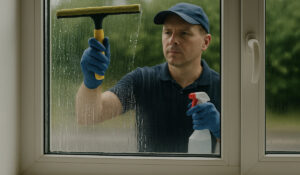When we talk about imposing buildings, it is impossible not to mention the 828-meter-high, 163-story Burj Khalifa in Dubai. This glass and steel colossus symbolizes architectural evolution, but it also poses a gigantic challenge: how do you keep a structure of this size clean and functional? The answer lies in rope access, a technique that has gained ground in large cities and is now a true revolution in building maintenance.
What is an RDS system and how does it work?
RDS, or Rope Descent System, is a work method that allows technicians to access building facades in a controlled manner using ropes, harnesses, anchors and descent and ascent devices. This technique, also known as rope access, involves suspending the worker from the top of the structure, allowing them to move safely and efficiently across the building surface.
Rope access is suitable for both mid-rise and high-rise buildings, allowing window cleaning, façade maintenance, technical inspections and other specialized tasks to be performed without the need for bulky structures.
Key advantages of rope access over gondolas and hoists
1. Flexibility: RDS systems make it possible to reach hard-to-reach areas where gondolas cannot reach.
2. Reduced architectural impact: no permanent or invasive structures are required.
3. Efficiency: assembly and disassembly time is reduced, optimizing execution times.
4. Reduced costs: by eliminating the use of cranes or heavy equipment, significant savings are achieved.
5. Versatility: adapts to any type of building, regardless of its geometry or complexity.
Vertical cities and the growing demand for RDS
In cities such as New York, Toronto, Dubai, Hong Kong or Mexico City, where vertical density is a constant, rope access has gone from being an alternative to becoming the preferred option for maintenance and cleaning. The increasing construction of skyscrapers and buildings with complex shapes has driven the demand for safe and efficient solutions such as RDS.
The rise of modern architecture has led to more and more buildings incorporating facades with large glass surfaces, cantilevers or irregular designs, making it difficult to use traditional methods and positioning rope access as the best alternative.
Safety in RDS work: Is it really a safe method?

Yes, as long as it is carried out under strict protocols. Rope access operators receive specialized training and official certifications. In addition, they use double rope systems (working line and safety line), certified anchors and personal protective equipment that comply with international standards.
Preliminary inspections, equipment maintenance and constant supervision ensure that this method is as safe as any other system, provided it is performed in a professional manner.
Common problems
– Adverse weather conditions that can delay or suspend work.
– Obsolete or poorly maintained equipment that increases risks.
– Lack of training or certification of personnel.
– Inadequate supervision of tasks.
When to consult a professional?
Whenever cleaning, maintenance, inspection or repair of medium- or high-rise facades is required, specialized companies should be consulted. A professional diagnosis will determine whether rope access is the best solution and ensure that the work is carried out safely and efficiently.
Rope access has not only proven to be a safe and efficient technique, but has also established itself as the most practical alternative for vertical cities.
Thanks to its ability to adapt to all types of geometries and conditions, its operational efficiency and low architectural impact, it has become an indispensable solution in modern building maintenance.
At Sapphire Window Cleaning, we are proud to be your reliable and specialized provider of window cleaning and maintenance services for mid-rise and high-rise buildings.
Our commitment to excellence, coupled with the use of innovative techniques and state-of-the-art equipment, ensures that your property receives the care and attention it deserves, maintaining its impeccable appearance and extending the life of your facility.
Are you ready to improve the appearance and durability of your property? We invite you to learn more about our services by visiting our website or contacting us through this link.
At Sapphire Window Cleaning, we are committed to providing you with exceptional quality service and professional attention that exceeds your expectations.
Notice
“Before making decisions that may affect the safety or performance of your property, it is always advisable to seek professional advice.”
Frequently Asked Questions
1. What is rope access?
Rope access is a specialized technique that allows technicians to perform cleaning, maintenance or inspection tasks on tall buildings using rope systems, harnesses and certified equipment.
2. What does RDS stand for when working at height?
RDS stands for Rope Descent System. It is a method that allows professionals to perform work at height safely by moving along facades using rope access.
3. Is rope access safe?
Yes, as long as it is performed by certified personnel and in compliance with international safety standards. It uses double rope systems, certified anchors and standardized procedures.
4. What kind of maintenance can be done with rope access?
Window cleaning, facade inspection, structure repair, joint sealing, signage installation, electrical system maintenance and much more can be performed.
5. Is it better than using gondolas or elevators?
It depends on the project, but rope access is often more versatile and cost-effective, especially in hard-to-reach areas where hoists do not work properly.
6. What training does a rope access technician need?
He/she must receive specialized training, comply with internationally recognized certifications and undergo periodic refresher and rescue training.
7. How do I know if my building is suitable for rope access?
Almost any building can be intervened with rope access, as long as it has anchor points or the possibility of installing them safely. A technical diagnosis will determine this.
8. What are the benefits of rope access compared to other methods?
Cost reduction, speed of execution, less visual impact, flexibility to adapt to any architectural design and greater safety if correctly implemented.
9. What happens if weather conditions are adverse?
Rope access works are not carried out in strong winds, heavy rain or thunderstorms, always guaranteeing the safety of the workers.
10. Can it be used in historic or irregularly shaped buildings?
Yes, this is one of the great benefits of rope access, since it allows intervention in structures with complex geometries without damaging the façade or altering its aesthetics.
11. How long does it take to perform cleaning or maintenance with RDS?
Rope access is usually faster than other systems, as it does not require the erection of heavy structures. The time will depend on the size and condition of the façade.
12. What equipment is used in rope access?
Certified ropes, harnesses, descenders, ascenders, blockers, helmets, safety lines, anchors and fall arrest systems.
13. What is the useful life of rope access equipment?
It depends on use and maintenance, but generally, ropes and equipment should be replaced every few years or after any event that compromises their safety.
14. What certifications are there for RDS work?
There are international certifications such as IRATA, SPRAT and OSHA standards, which guarantee proper training and safety in rope access work.
15. Why is its use growing so much in large cities?
Because cities are increasingly vertical, facades are more complex and rope access offers a safe, economical and adaptable solution for all types of modern buildings.




